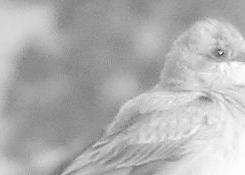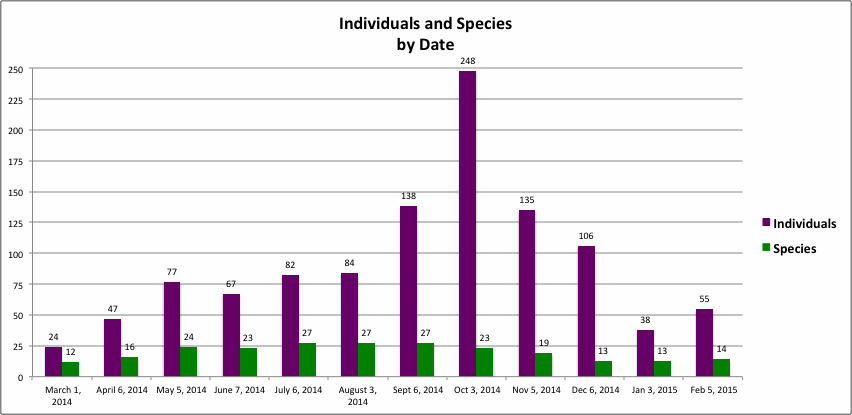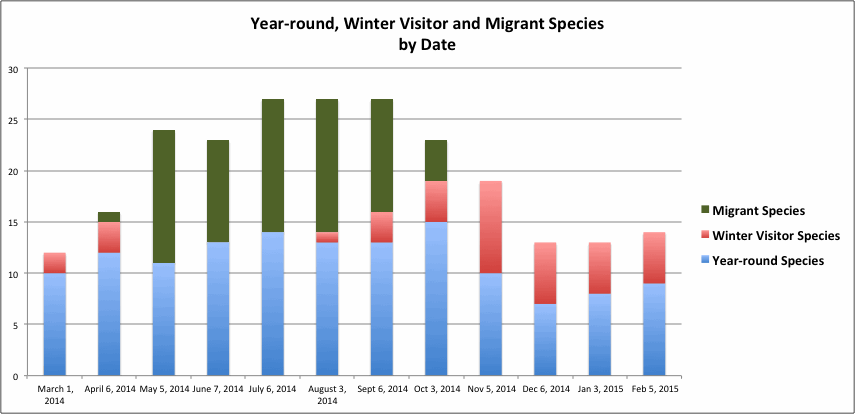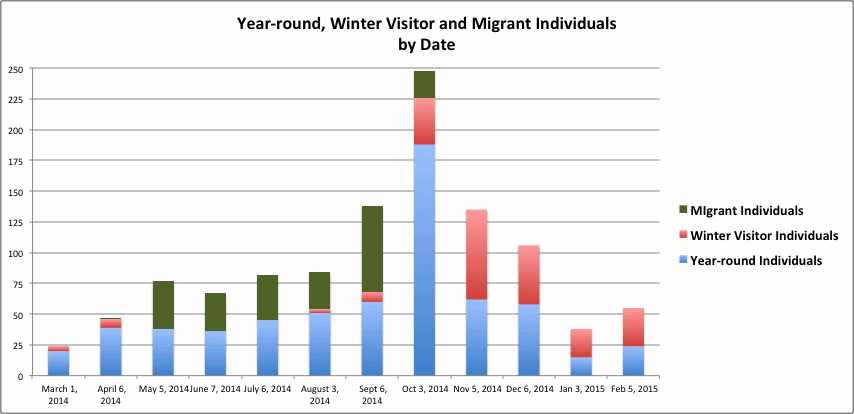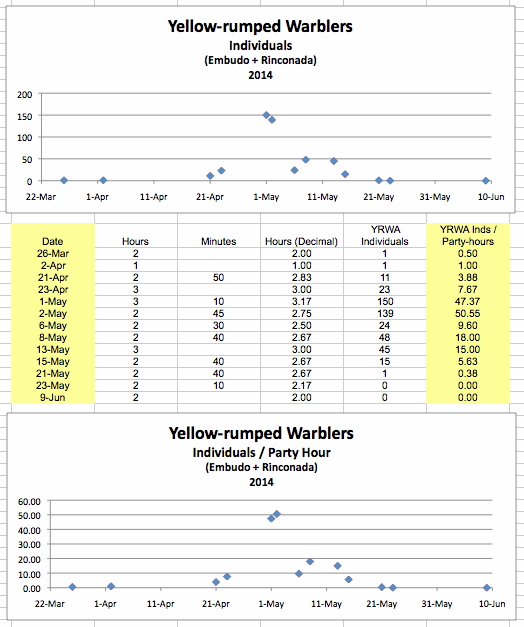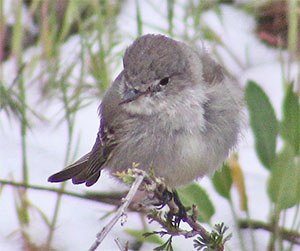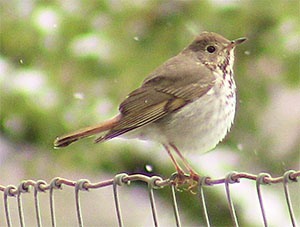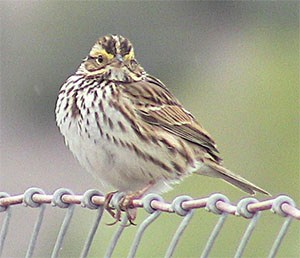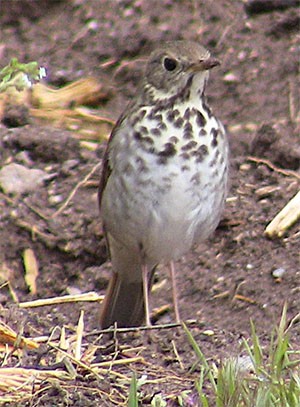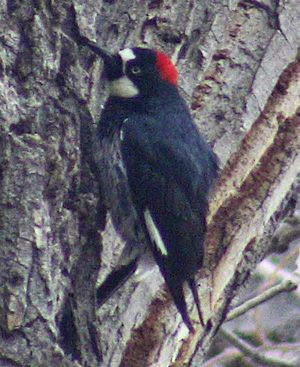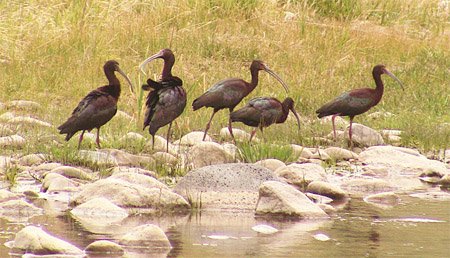- List of Species Observed in RioEmbudoBirds.org area (Updated 2023):
- All Seasons, All Species
- Species Present All Year
- Winter Visitors
- Spring-Fall Transients
- Migrant Summer Breeders
- Non-breeding Vagrants
- Observing Birds
- Local Bird Counts
- Bird Migration
- Bird Song and Sound
|
Spring Fed Arroyo - 12 Months of Data: Changes in Species Diversity and Numbers of Individuals through the seasons in a Spring-fed Arroyo in Northern New Mexico. Go to SpringFedArroyo Home Arroyos are everywhere in New Mexico. We mostly see the lower reaches of arroyos. They come in every size. Often we see them as wide, dry washes not long before they empty into a nearby river. What is often not seen are the upper reaches of the arroyos. A walk up an arroyo will often reveal a stand of Cottonwoods, a sure sign of water. The water is usually in the form of a spring emerging out of the Piñon-Juniper woodland. This informal study is based on monthly visits to such a "spring-fed arroyo". More than 20 different birders have participated at one time or another. The initial impetus for the project was simply to experience the seasonal changes in one location. To sense and feel the cyclical nature of a place. The activity of life is, at its essence, cyclical, driven by Earth's movement in space. The rotation of the Earth on its axis underlies the daily cycle. The Earth's orbit around the sun, coupled with the tilt of the Earth's axis results in the yearly cycle of seasons. These powerful forces shape all animals' (including Humans) movement on the Earth's surface. For birds: daily feeding rounds and seasonal migrations of epic proportions. The birds observed on these walks are categorized as Year-round Birds, Winter Visitors and Neo-tropical Migrants. The seasonal cycle is clearly demonstrated in the flux of species over time. Monthly observations will continue through the winter. Graphs of the collected data and informal analysis is available here: Go to SpringFedArroyo Home. Other Locations: This kind of observation could be carried out in virtually any location. From one's backyard, to a street in downtown Santa Fe or Taos, similar cycles would be observed. An hour a month, just outside your front door. You'll be amazed! |
August 16, 2014:Spring Migration Peak Detection: May, 2014 Background: During the 2014 Spring Migration, I monitored two locations on the Rio Grande on a regular basis. One was on private property in Embudo, the other partly on private property in Rinconada. Both sites included extensive riparian, agricultural and Piñon-Juniper habitat. The downstream (Embudo) site covers 1.2 miles of river, but with adjacent agricultural and Piñon-Juniper areas, the walk was 1.75 miles one-way. There was a 0.25 mile break between the downstream and upstream sites. The upstream (Rinconada) site covers 1.5 miles of river with a one-way distance of 1.75 miles. On each count, I would walk back by the same route, recording only new species or replacing the number of individuals of a species already recorded, if I saw a greater number all at the same time. The end of the count time would be the time at which I made the last recording. As you will see in the data, the sites were monitored from March 26th through June 9th. From April 21 through May 23rd, I monitored the downstream site on one day and the upstream site two days later. After a pause of 4-8 days, I would repeat the pairing. Purpose: The overall goal was simply to get a more precise understanding of the timing of the Spring migration on the Rio Grande. One hope was that I would be able to detect the peak of the migration pulse if one existed. From the data below, it appears that there was a detectable peak for some species. I present data for three of those species.
Yellow-rumped Warbler: The upper graph plots the number of individuals counted versus time. The lower graph plots the effort-adjusted count versus time.
The graph clearly shows a peak at the beginning of May. Since there was no observation between April 23rd and May 1st, it is possible that the peak was actually between those dates. The treatment of the data for the Orange-crowned Warbler is the same as for the Yellow-rumped Warbler 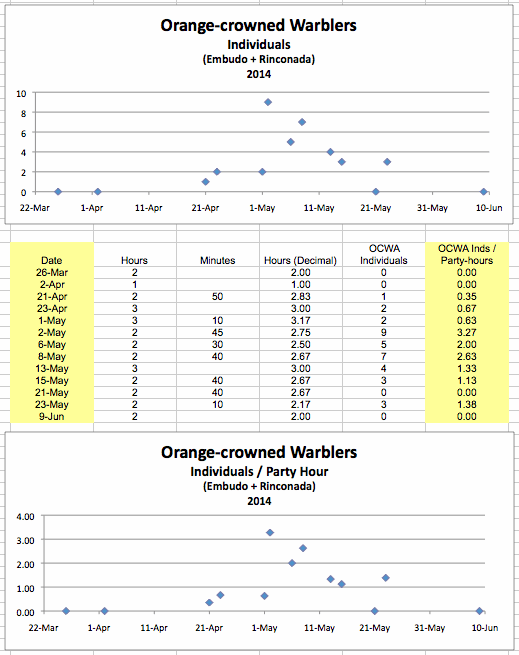
The peak of the Orange-crowned's migration appears to have occurred in the first week of May. In the analysis of the Violet-green Swallow, I included data from a wider range of locations. In addition to the Embudo and Rinconada sites, counts from Dixon (Rio Embudo) and Orilla Verde Recreation Area (Rio Grande). There was also a different protocol when "back-tracking". Because of the nature of flocking and flying among the swallows, no changes were made when back-tracking. 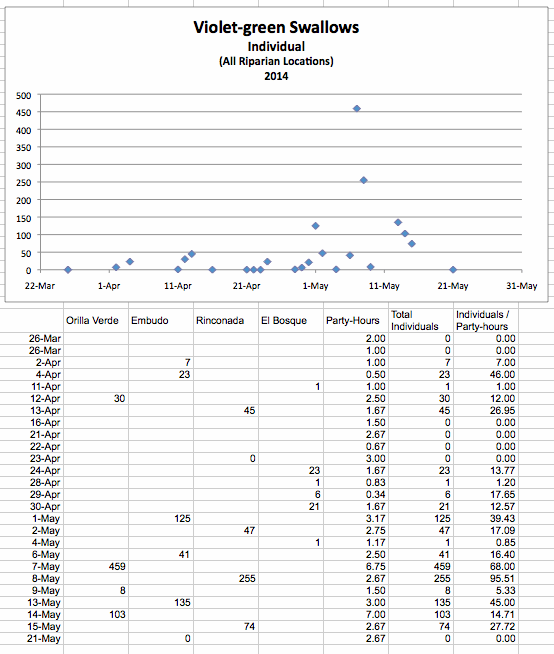
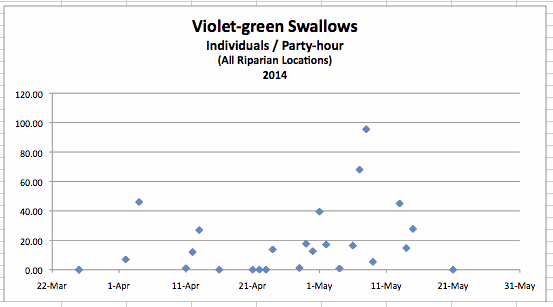
The peak of the Violet-green Swallow migration appears to be at the beginning of the 2nd week of May. This is consistent with a North American Migration Count done in Orilla Verde on May 10th, 2003 in which we recorded 661 VGSW. That data point appears in the graph below. Unfortunately, we do not have data from just before and just after that count. The counts of VGSW in this table were all made on the 2nd Saturday of May in the years shown. Not having data from surrounding dates in each year make it difficult to draw any strong conclusions from these data, but it is interesting that the one very high count coincides with the 2014 migration peak. Only continued study will reveal if this is a yearly peak. One possibiblity for further study would be a detailed analysis of eBird records for northern New Mexico during April and May. 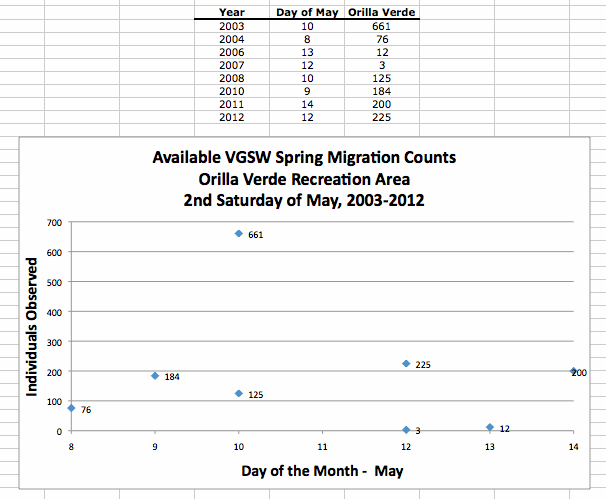
|
August 15, 2014:Spring Migration Songbird Fallout: May 12-13, 2014 On May 13, 2014, I was scheduled to do a count on a private property along the Rio Grande in Embudo. It started snowing in the wee morning hours and was still lightly snowing when I left home to drive to Embudo. I had planned to start the count at 7:00am, but at that time it was snowing hard. From the weather map, it seemed the snow might clear up by 9:00 or so. 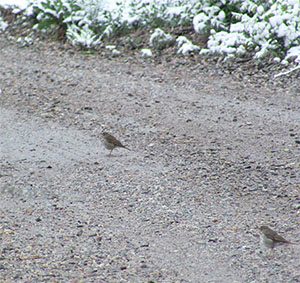
Driving out on my road at 8:45, I was surprised to see three birds feeding on the gravel ahead of me. It was completely overcast and at first glance, I thought they must be Canyon Towhee. But as I got closer they clearly were not and when I got my binoculars on them, they appeared to be Hermit Thrush. The light was poor, but I did get a noisy, out-of-focus picture (see below), which I zoomed on my camera to verify the Hermit Thrush ID. I thought it was strange to see three Hermit Thrush together like that. They are generally fairly secretive and once seen, usually move into nearby cover and disappear. These three were out in the open, seemed intent on feeding and were not running to hide. 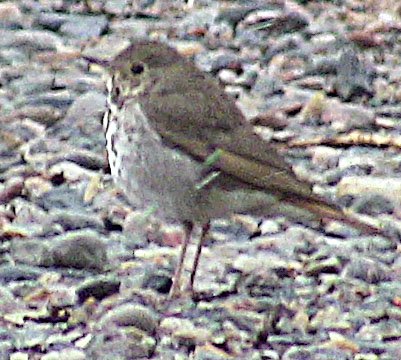
I drove on to Embudo to start my count. The sighting of the three Hermit Thrush seemed odd, but I was focused on getting started on my count and it had dropped out of my thought as I parked my car and started walking across the bridge over the Rio Grande. By the time I had crossed the water, I had recorded 2 Cassin's Kingbird, a White-breasted Nuthatch, a Black-capped Chickadee, 3 Yellow-rumped Warblers, a lone Canada Goose on the water, an American Crow flying north, and a Say's Phoebe. As I neared the end of the bridge I noted an Empidonax genus flycatcher in a Russian Olive and then a second one immediately came into view. I usually only see a few Empidonax in a season. Seemed like a very active morning. It was near the peak of the Spring migration, but even so... As I left the bridge and turned down a dirt road I was amazed to see a Hermit Thrush, no, 2 Hermit Thrush, no, 3, no, 4, 5, 6 in one view. They were spaced out along a 50-yard stretch of the road, feeding just like the three in my road. It was still snowing lightly and at this point is dawned on me that I was seeing a spring migration "fallout". A "fallout" occurs when a spring storm forces migrating birds to land unexpectedly. The species involved in this fallout generally migrate at night. When this snowstorm began in the night, the birds were probably forced down wherever they were and once it was light, they found the river and began feeding again to prepare for the next leg of their journey. During the next 3 hours I would go on to record 12 Hermit Thrush, 5 Gray Flycatcher (one of the Empidonax species) and 18 Unidentified Empidonax. Click Here to see Full List The walk on this count is 1.75 miles one way (downstream). When I make the return trip, I always review what I have seen and see if the numbers seem right. I did that this time, with particular attention to the Hermit Thrush and the flycatchers. I counted a similar number on the return. There were several other species, though not as numerous, of which I saw my usual yearly number on that day. I often see only one or two MacGilivray's Warbler in a season and only rarely see Vesper Sparrow and Savannah Sparrow. I detected 3 MacGilivray's. I saw one Vesper Sparrow, but heard others and saw one Savannah Sparrow. By the time I saw the Sparrows, the sky had brightened a bit and I finally got better pictures of the thrush as well as the sparrows: 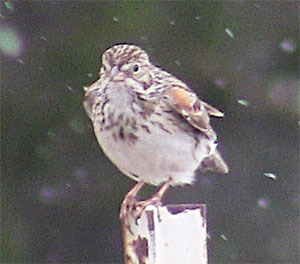 Vesper Sparrow Embudo: May 13, 2014 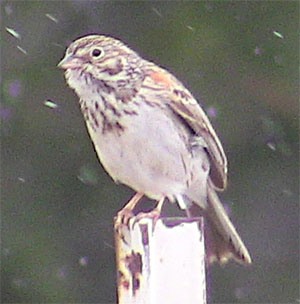 Vesper Sparrow Embudo: May 13, 2014 Finally, on returning to my road about 12:30pm, I counted 5 Hermit Thrush in 0.25 miles, including this one that was feeding in my freshly planted Rye field: When I got home, there was an email from a friend in Pilar, about 7 miles to the northeast on the Rio Grande: "Three inches of settling, fluffy snow here in Pilar. Here's what's outside my window: Hermit Thrush (2) under the forsythia, Orange-crowned Warbler, Wilson's Warbler and Virginia's Warbler in the rose bush, Townsend's Warbler (female) and two Yellow-Rumped Warbler in the Pinon, Bullock's male & female at the hummingbird feeder, Black-chinned and Broad-tailed hummers..." In the next email: "Whoops! Forgot the UEFL!" (UEFL is the four-letter code for Unididentified Empidonax Flycatcher.) |
July 13, 2014:
Spring Migration Count, Taos County The North American Migration Count (NAMC) began in 1992. The concept was expressed in a web page by the founder: North American Migration Count The idea of capturing a "snapshot" of the spring migration is a compelling idea. This rationale is further developed in a statement from Cornell's Lab of Ornithology site All About Birds: North American Migration Count at All About Birds Having participated in either the Rio Arriba or Taos county count since 2006, I became interested in seeing what results might have been developed. Extensive Internet searching failed to turn up any sign of a national repository of NAMC data. What I found was that most efforts were at a state or county level, with some websites providing access to data. Arizona NAMC data is available on this website: Arizona Field Ornithologists. Here is the organizational page for the Oregon effort: The East Cascades Audubon Society. This website makes available data from one county in Michigan: Rouge River Bird Observatory. From inquiries among other New Mexico birders, I discovered that the New Mexico Ornithological Society had archived and published NM NAMC data for a number of years, but had stopped. When I began doing the NAMC counts, I assumed that the data was being curated much like the Audubon Christmas Bird Count. This is obviously not the case. Many, many birders have invested a great deal of energy over the years, both as counters and as organizers. A great deal of valuable data have been generated and it would be useful if those data were made available to the ornithological community in the wav the CBC data is. Enter eBird. Administered by the Cornell Lab of Ornithology and the National Audubon Society, eBird is an international database of bird observations. Anyone can enter their observations and also explore and obtain data from the database. This Wikipedia entry provides a good overview of eBird: Wikipedia on eBird There has been some debate about the usefulness of eBird data, but two developments are instructive: First, eBird scientists have generated animated migration maps for many species. These maps provide the "snapshot" of migration which was the primary goal for the NAMC. However, the snapshot is not limited to a single day. It shows distribution and relative abundance across the entire year. You can explore these animated "occurrence maps" here. Second, a recent study by a Cornell researcher is using eBird data to refine what is known about North American migration flyways. Click here to read about the study. Taos Migration Count in 2013 The 2013 count plan was to cover four critical habitats on four different half-day counts. This departure from the NAMC format allowed each habitat to be visited during the early morning hours when bird activity generally peaks. Results would be entered into the eBird database. The locations selected were Carson Mesa (Sage brush), Pot Creek (Extensive wetlands), Taos Ski Valley (High Montane Forest), Orilla Verde Recreation Area (Riparian and Piñon-Juniper). The counts were carried out by Meg Peterson, Isabella Draper, Diane Gledhill and myself. Here are the overall results: Taos 2013 Migration Count Data Here is the same data segregated differently for inclusion in eBird: Links to some Taos Many CBC compilers are now entering each year's CBC data into eBird. The old NAMC data represents valuable records that could become part of the eBird database. The yellow box at the right contains links to old Taos NAMC data not yet entered into eBird. It seems that spending prime time in each habitat may have provided a more thorough assessment of species present. The following species, recorded this year, were generally missed on the day-long count format: Finally, two photos. The first is from the town of Pilar where we observed this Acorn Woodpecker. The second is what greeted me on the Rio Embudo just a 1/4 mile from my house when I was driving back from the May 11th count. |
Copyright 2006-2021 by Rio Embudo Birds.org --- All rights reserved.
